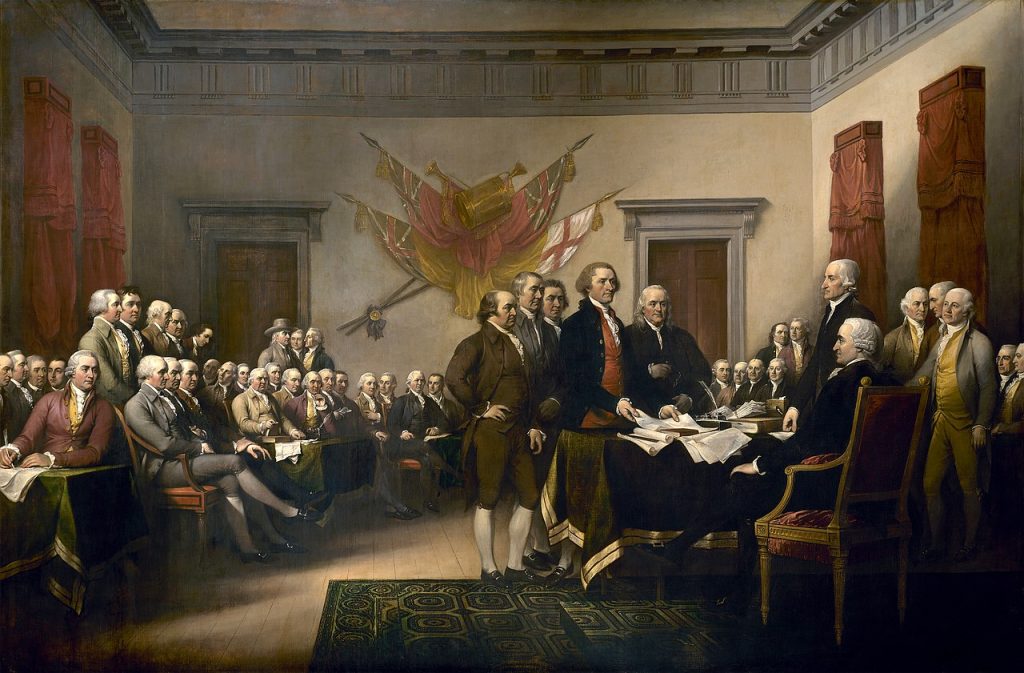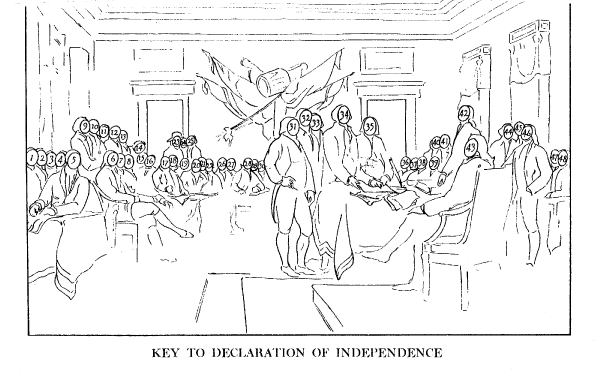
Jump to key figures in this painting.
The most frequent historical criticism of this painting is that it depicts a scene that never took place. To understand, we need to look at the historical background.
The chronology of the Declaration of Independence is that the initial resolution that the “Colonies are, and of right ought to be, free and independent States” (still preserved in the handwriting of R. H. Lee) was introduced June 7th, debated on the 8th and 10th and further consideration postponed until July 1st. Meanwhile, a committee to draft a Declaration was appointed consisting of Jefferson, John Adams, Franklin, R. R. Livingston and Sherman. A draft was submitted June 28th, debated by the Congress acting as a committee on July 1st and adopted. The draft was adopted by the full Congress on the 2d; debated again on 2d, 3d and 4th and finally adopted with amendments on July 4, 1776. On July 19th it was ordered to be “engrossed on parchment” and “when engrossed be signed by every member of Congress.” The engrossed resolution was not signed until August.
Historians criticize the painting because they feel that it should represent either the scene on June 28th when the Declaration was reported, or on July 4th when it was adopted, and they point out that Trumbull has included portraits of men who were not present on one or both of these occasions and excluded others who were.
That assumes, however, that Trumbull meant to memorialize one or both of these events. He did not. He neither called his work “The Submission of the Declaration”, nor “Congress Adopting the Declaration” nor “The Signing of the Declaration.” It is “Declaration of Independence” and was meant by Trumbull “to preserve the resemblance of the men who were the authors of this memorable act.” Actually, it was on July 2d that the Congress declared the Colonies to be independent, and on July 4th the form only of that Declaration was determined.
Trumbull himself pointed out the difficulties that confronted him and what he did was to use the original act as the “general guide” but preserved for posterity whatever likenesses he could obtain of those engaged in this momentous event, which proved to be no mean feat.
Many of the portraits were painted directly onto the canvas from life between 1789 and 1794, as Trumbull returned to New York upon the meeting of Congress there in December of 1789 for that purpose. He is said also to have carried the canvas about the country with him to take advantage of any occasion which might arise. Possibly a few were done from pencil portraits, as there existed in Trumbull’s effects portrait sketches of George Wythe drawn at Williamsburg, April 25, 1791; Samuel Chase; and John Hancock (signed “Governor Hancock, Boston, Nov 25, 1790”). Trumbull has given us the dates of painting in some of the portraits: Adams, in London during the summer of 1787; Jefferson, in Paris in September, 1787; Arthur Middleton, Thomas Heyward and Edward Rutledge, at Charleston in February of 1790. Fifteen men who signed the Declaration are not represented, probably because they were either not present at the actual adoption or were dead at the time of Trumbull’s painting.
The portraits of four who were present at its adoption but who did not sign the Declaration, George Clinton, Robert R. Livingston of New York, Thomas Willing of Philadelphia, and John Dickinson of Delaware, are included. Trumbull’s reason was that portraits of those who opposed should be given also, “particularly John Dickinson of Delaware, author of the Farmer’s Letters, who was the most eloquent and powerful opposer of the measure; not indeed of its principle, but of the fitness of the time, which he considered premature.”
Interestingly, shortly after the Civil War, a man who apparently had more money than sense wanted a collection of likenesses of ALL the signers of the Declaration of Independence, although there were no authentic portraits known to exist for several of them. Despite this apparently insurmountable difficulty, in due time there appeared etched portraits, purportedly done by one H. B. Hall, of Francis Lightfoot Lee, William Whipple, George Taylor, James Smith, Lyman Hall, John Hart, Caesar Rodney, Button Gwinnett, John Penn, Benjamin Harrison, and Carter Braxton, which to-day are looked upon by the uninitiated as genuine portraits.
What is worse yet is that fake portraits of at least four of the signers of the Declaration of Independence can be found within the sacred portals of the room where the immortal document was adopted. On the walls hang likenesses which are supposedly of John Hart and of George Taylor, neither of which have the slightest pretense of authenticity as portraits of those worthies, while others of William Whipple and Benjamin Harrison have been there a longer time but without any better pedigree. The facts evidencing the faking of the Whipple portrait in particular are clear. The catalogue of works of art in Independence Hall states that the portrait of William Whipple is after St.Memin. Whipple died in 1785, and St.Memin was not born until 1770 and did not come to America until 1793. Research among the engraved portraits by St.Memin discloses the fact that the alleged picture of William Whipple in Independence Hall is in fact a portrait of a Joseph Wipple (note the spelling) which was drawn and engraved by St.Memin in 1805.
Of the portraits in Trumbulls picture, we have his own record. In a letter to Jefferson reporting his progress in enlarging it for the Capitol, Trumbull says: “you recollect the composition which you kindly assisted me to sketch at Chaillot…The picture will contain Portraits of at least Forty seven members: – for the faithful resemblance of at least Thirty six, I am responsible, as they were done by myself from the Life, being all who survived in the year 1791. Of the remainder, nine are from pictures done by others. One General Whipple of New Hampshire is from memory; and one Mr. Benj. Harrison of Virginia is from description aided by memory.” Trumbull wrote General Harrison (February 10, 1815), that: ” Mr . Peale…possesses no portrait of your Father in his Museum. My sole reliance must be on such description as you and his friend Colo. Meade of Kentucky can furnish me.”
The scene itself was no less difficult for Trumbull to reproduce.
In an inventory of now-lost Trumbull papers, there is a reference to a sketch entitled “The first idea of the Declaration of Independence, Paris Sept. 1786.” And also a reference to a sketch on the same sheet endorsed by Trumbull: “Done by Mr. Jefferson, Paris, 1786 to convey an idea of the room in which Congress sat at the Declaration of Independence, on the ground floor of the Old State House in Philadelphia, – Left hand at entering.” It was during Trumbull’s visit to Jefferson that he began this composition, “with the assistance of his information and advice” . Returning to London, Trumbull “composed and began” this canvas, leaving out the heads to be painted in as opportunity offered.
Trumbull himself alludes to the change in the architecture of the room in which the scene is laid. In a letter to John Adams he said: “I preserve faithfully the costume of the day, and the architecture of the Room, which I very much regret to find has lately been destroyed by that restless spirit of Change, which so much prevails in this Country.”
We know that the room painted by Trumbull is quite different in detail from its appearance on July 4, 1776, from the fact that Robert Edge Pine, a well-known English historical painter, came to America in 1784 and on November 15 The Pennsylvania Packet carried his advertisement that as he had been “honored with the use of a commodious apartment in the Statehouse, for the purpose of painting the most illustrious scenes in the late revolution” he invites the public to view his works. Pine died in Philadelphia November 19, 1788, and the inventory of his estate includes four unfinished historical paintings of the American Revolution, one of which was entitled “The American Congress Voting Independence.” This painting afterward came into the possession of Edward Savage and was finished and engraved by him. The detail of the architecture is totally different from that shown in Trumbull’s painting and accords with the period (1745) when the assembly room in the State House was finished.
Pine was a talented and trained historical painter and in 1784 he was occupying “an apartment” in the very building, so it cannot be doubted but that he accurately copied the details of the assembly or what is now known as the “Independence Chamber.” Pine’s painting was used as a guide in the restoration of the Chamber in 1900. The interior of the room would appear to have been completely changed after 1784, when Pine painted it. We know that Trumbull possessed Jefferson’s sketch made in Paris in 1786 and that there was, among Trumbull’s effects, “Joseph Sansom’s sketch of the room in which Congress sat at the Time of the Declaration of Independence”.
It is impossible to determine whether Trumbull adapted Jefferson’s sketch from memory or made use of Sansom’s in his picture, as both have disappeared. Probably it was imaginary, as the general style would accord with the time of Trumbull painting (1786). The chair (of Chippendale design) and the desk (Sheraton) actually used by Hancock are preserved in Independence Hall, and do not in the least resemble those painted by Trumbull.
The great value of this picture is as a human document, preserving as it does the portraits of forty-eight persons connected with the most momentous event in the worlds history next to Magna Carta. Had there been an artist present at Runnymede Field to preserve the likenesses of those nobles who wrung freedom from an unwilling King John, his canvas would have been considered of less importance only to the document itself. Trumbull’s painting of these bold men, who initiated the movement which procured freedom for us, should be ranked next to the engrossed resolution in the National Archives which is the object of such sentimental reverence.
Key figures in this painting
- George Wythe
- William Whipple
- Joseph Bartlett
- Thomas Lynch
- Benjamin Harrison
- Richard Henry Lee
- Samuel Adams
- George Clinton
- William Paca
- Samuel Chase
- Rich. Stockton
- L. Morris
- Wm Floyd
- A. Middleton
- T. Heyward, Jr.
- Charles Carroll of Carrollton
- Robert Morris
- T. Willing
- Benjamin Rush
- Elbridge Gerry
- Robert Treat Paine
- Wm. Hooper
- Stephen Hopkins
- Wm. Ellery
- George Clymer
- Joseph Hewes
- Geo Walton
- Jas Wilson
- A. Clark
- F. Hopkinson
- John Adams
- Roger Sherman
- Robert R. Livingston
- Thomas Jefferson
- Ben Franklin
- Thomas Nelson, Jr.
- Francis Lewis
- Witherspoon
- S.Huntington
- William Williams
- Oliver Wolcott
- Chas. Thomson
- John Hancock
- George Read
- John Dickinson
- Edward Rutledge
- Thomas McKean
- P. Livingston


